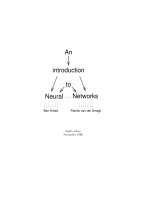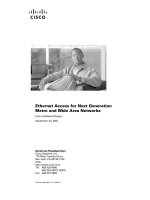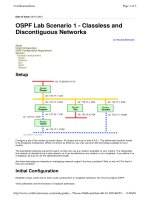Unit 28: Networks pptx
Bạn đang xem bản rút gọn của tài liệu. Xem và tải ngay bản đầy đủ của tài liệu tại đây (1.82 MB, 1 trang )
Unit 28 Networks
Name:
1 What do the following abbreviations stand for? Choose the correct answer.
1 LAN
local area network
large area network
2 PAN
private area network
personal area network
3 MAN
managed area network
metropolitan area network
4 WAN
wide area network
wireless area network
2
Look at these four extracts from a computing textbook. Which criteria is the writer using to
classify the networks he’s describing? Choose from the drop-down menu.
1 The most common examples of networks are LANs, PANs, MANs and WANs.
2 There are several languages that the computers on a network can use to
communicate with each other. For example, the Internet uses TCP/IP.
3 A client-server network differs from a peer-to-peer network in several ways, the
most important being that on a peer-to-peer network, there is no need for
a separate computer to act as a server.
4 The most common layouts for networks are bus, star and ring.
3 Complete the presentation describing the network on page 144 of the Infotech Student’s
Book by typing in words from the box.
central computer made up cables consists of log on modem
file sharing type in satellite wired telephone lines set up look for
fibre optic cable look at
Clare: If you (1) the diagram, you can see that it represents a wide area network, or
WAN, connecting two networks via (2) . The two networks are probably two offices of
the same company.
Chris: The (3) network on the right – the one in Barcelona – is (4)
of a number of PCs connected by (5) . You’ll be able to see the (6)
there, which acts as a file server, allowing (7) between the other PCs on the network.
In order to access files on the server, you would probably need to (8) a username and
password.
Clare: That’s right, Chris. In contrast, the Los Angeles network (9) a wireless router,
which links all of the hardware devices without the need for cables. Workers using PDAs or laptops, like
those shown in the diagram, would be able to (10) to the network if they had wireless
capabilities. Interestingly, while in Barcelona the (11) is linked to the dish aerial with a
(12) , in Los Angeles they’re using regular (13) . This may mean
slower speeds for the Los Angeles office.
Chris: It looks like this network was (14) to allow the two offices to
(15) and share information and resources on each other’s systems, and
it’s a sensible network solution for a company with offices in several different locations.
Now listen to the presentation.
HELP?









